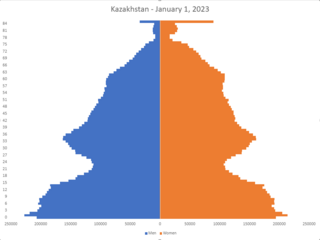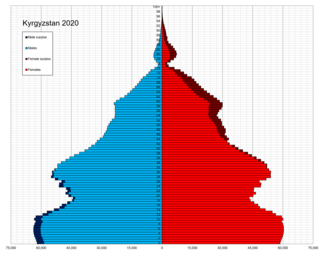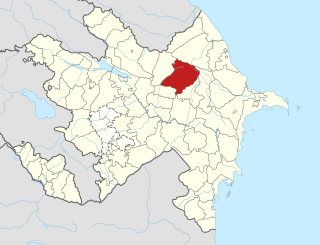
The demographics of Kazakhstan enumerate the demographic features of the population of Kazakhstan, including population growth, population density, ethnicity, education level, health, economic status, religious affiliations, and other aspects of the population. Some use the word Kazakh to refer to the Kazakh ethnic group and language and Kazakhstani to refer to Kazakhstan and its citizens regardless of ethnicity, but it is common to use Kazakh in both senses. It is expected that by 2050, the population will range from 23.5 to 27.7 million people.

The Demographics of Kyrgyzstan is about the demographic features of the population of Kyrgyzstan, including population growth, population density, ethnicity, education level, health, economic status, religious affiliations, and other aspects of the population. The name Kyrgyz, both for the people and the country, means "forty tribes", a reference to the epic hero Manas who unified forty tribes against the Oirats, as symbolized by the 40-ray sun on the flag of Kyrgyzstan.

Ismayilli District is one of the 66 districts of Azerbaijan. It is located in the north of the country and belongs to the Mountainous Shirvan Economic Region. The district borders the districts of Qabala, Quba, Goychay, Kurdamir, Agsu, Shamakhi, and the Russian Republic of Dagestan. Its capital and largest city is Ismayilli. As of 2020, the district had a population of 87,400. It is believed that this district was named after a highly respected elder and philanthropist in the community, Ismayil Baghiyev.

Yardimli District is one of the 66 districts of Azerbaijan. It is located in the south-east of the country and belongs to the Lankaran-Astara Economic Region. The district borders the districts of Jalilabad, Masally, Lerik, and the Ardabil Province of Iran. Its capital and largest city is Yardimli. As of 2020, the district had a population of 68,000.

The Karakalpak Autonomous Soviet Socialist Republic, also known as Soviet Karakalpakstan or simply Karakalpakstan, was an autonomous republic within the Soviet Union. Until 20 July 1932, it was called the Karakalpak Autonomous Oblast. On 5 December 1936, it was moved from the Russian SFSR to the Uzbek SSR. It was the only ASSR in Soviet Central Asia.

The Nagorno-Karabakh Autonomous Oblast (NKAO) was an autonomous oblast within the Azerbaijan Soviet Socialist Republic that was created on July 7, 1923. Its capital was the city of Stepanakert. The leader of the oblast was the First Secretary of the Nagorno-Karabakh Autonomous Oblast Committee of the Communist Party of Azerbaijan. The majority of the population were ethnic Armenians.
Turks in Ukraine are people of Turkish ethnicity living in Ukraine. The first Turkish settlement started during the Ottoman rule of Ukraine. In addition, there has been modern migration to the country largely formed of Meskhetian Turks, followed by immigrants from Turkey and Turkish communities from other post-Ottoman territories, such as Turkish Cypriots from Northern Cyprus.
The Chechen diaspora is a term used to collectively describe the communities of Chechen people who live outside of Chechnya; this includes Chechens who live in other parts of Russia. There are also significant Chechen populations in other subdivisions of Russia.
Turks in Russia, also referred to as Turkish Russians or Russian Turks, refers to people of full or partial ethnic Turkish origin who have either immigrated to Russia or who were born in the Russian state. The community is largely made up of several migration waves, including: descendants of Ottoman-Turkish captives during the Russo-Turkish wars; the Turkish Meskhetian community; and the more recent Turkish immigrants from the Republic of Turkey.

Turks in Kazakhstan are ethnic Turks who live in Kazakhstan, mostly from Meskheti after the Deportation of the Meskhetian Turks.
Turks in Uzbekistan are ethnic Turks who live in Uzbekistan.

The Kurds in Azerbaijan,, form a part of the historically significant Kurdish population in the post-Soviet space. Kurds established a presence in the Caucasus with the establishment of the Kurdish Shaddadid dynasty in the tenth and eleventh centuries. Some Kurdish tribes were recorded in Karabakh by the end of the sixteenth century. However, virtually the entire contemporary Kurdish population in the Republic of Azerbaijan descends from migrants from 19th-century Qajar Iran.
Turks in the former Soviet Union were a relatively small minority within the Soviet Union when excluding Turks of Azerbaijan, Oguz Turks and other Turkish groups. However, their presence is considered important within Turkology due to the deportation of thousands of Turks from their home countries. Under the Ottoman Empire, Samtskhe-Javakheti was heavily Islamised producing a Turkish ethnicity within the southwestern region of Georgia. In November 1944, up to 120,000 of these Turks were deported to Central Asia under the rule of Joseph Stalin.
Ingiloys are an ethnographic subgroup of Georgians who speak the Ingiloy dialect of Georgian. Ingiloys are indigenous to Saingilo, a cultural and historical region located in the northwest of present-day Azerbaijan.

Russians in Azerbaijan are the second largest ethnic minority in Azerbaijan and is also the largest Russian community in the South Caucasus and one of the largest outside of Russia. Although in decline, the community still numbers 119,300 people as of 2009. Since their arrival at the beginning of the 19th century, the Russians have played an important role in all spheres of life, particularly during the Czarist and Soviet period, especially in the capital city of Baku.

The Kurds in Georgia form a major part of the historically significant Kurdish population in the post-Soviet space, and are members of the eponymous ethnic group that are citizens of Georgia. In the 20th century, most Kurds fled religious persecution in the Ottoman Empire to the Russian Empire. The return of their Kurdish surnames needs effort according to a Kurdish activist in Georgia. The Kurds also have their own schools, school books and a printing press in Georgia. Illiteracy among them disappeared in the early 1900s. Kurds in Georgia are politically neutral; however, in 1999 they staged a huge demonstration in Tbilisi, demanding the release of the founder of the Kurdistan Workers' Party, Abdullah Öcalan. Kurds in Georgia today use Cyrillic script. Earlier, in the 1920s, they used the Latin script.
Armenians in the Baltic states of Estonia, Latvia, and Lithuania settled there mostly during the Soviet occupation of the Baltic States, although some of the first settlers arrived during the Russian Empire's rule in the Baltics.

Kurds in Russia form a major part of the historically significant Kurdish population in the post-Soviet space, with close ties to the Kurdish communities in the Caucasus and Central Asia.

The Kurds in Turkmenistan form a part of the historically significant Kurdish population in the post-Soviet space, and encompass people born in or residing in Turkmenistan who are of Kurdish origin. In the 17th century, Abbas I of Persia and Nader Shah settled Kurdish tribes from Khuzestan alongside the Iranian-Turkmen border. More Kurds arrived to Turkmenistan in the 19th century to find unclaimed land and to escape starvation.
Azerbaijanis in Kazakhstan are part of the Azerbaijani diaspora. They are Kazakh citizens and permanent residents of ethnic Azerbaijani background. According to the 2009 census, there were 85,292 ethnic Azerbaijanis living in Kazakhstan; Azerbaijanis comprised 0.5% of Kazakhstan's population and were the country's tenth-largest ethnic minority.











